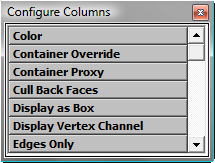The Scene Explorer columns provide information on and means to edit various properties of scene contents in 3ds Max. These include text strings, check boxes, numeric quantities, and more. You can also sort the Scene Explorer listing by clicking a column heading (a second click reverses the sort). Additional methods for using columns are available; see the Procedures section that follows.
 Autodesk 3ds Max 2012 has two new columns to help you manage objects linked from the File Link Manager. Application Origin shows the name of the Autodesk application that created the FBX file, and File Linked shows the name
of the source file that is linked to the current scene.
Autodesk 3ds Max 2012 has two new columns to help you manage objects linked from the File Link Manager. Application Origin shows the name of the Autodesk application that created the FBX file, and File Linked shows the name
of the source file that is linked to the current scene.
This opens the Configure Columns dialog.

The new column is inserted to the left of the existing column.
To replace a column in the table:
To remove a column from the table:
To sort the list based on a column or columns:
This performs a single-level sort based on the column contents, in ascending order, as indicated by up arrow on the right side of the heading. For example, clicking the Name column sorts the table in ASCII order, starting with punctuation, then numbers, then letters.
Alternatively, right-click a column heading and choose Sort Ascending or Sort Descending. You can sort any number of different columns this way to perform a multi-level sort. For example, you could sort by type, and then, within that sort, by whether the objects are hidden.
This section lists the available columns, briefly describes each column’s function, and notes whether the column appears by default in Scene Explorer.
The wireframe color of the object.
To change the color, click the color swatch; this opens the Color Selector dialog.
The number of faces in the object. By default, this is the number of triangular faces, but with polygon-type objects such as editable poly, it’s the number of polygons. For example, the default box primitive has 12 faces, but if you convert it to editable poly, the Faces column value changes to 6. Other modifiers can also change this value.
For a light, the Size value of the shadow map.
For shadows, the value of the shadow bias setting that adjusts the shadow position.
For shadow-mapped shadows, the sample range setting.
 Application Origin
Application OriginThis information is generated by the original application. For Autodesk FBX files and DWG files, the column is blank. For Revit FBX files, the name of the program appears. Revit needs to identify itself because the FBX importer needs to know whether the FBX file includes Revit metadata.
 File Linked
File LinkedThis information appears only for renderable geometry. It does not appear for other objects such as lights, cameras, skeletal animation rigs, and so on.
For a container, whether the contents are inherited.
For a container, whether its contents are currently loaded in the scene.
For a container, whether it is currently open.
If the container is a source container that does not allow you to edit it, this field shows a check mark but is disabled.
For a container, shows the originator’s network ID (user name) when open. The field is empty when the originator has closed the container.
This field updates automatically when the container status changes.
For a container, whether Override Object Properties is on.
The same control is available on the Display rollout and as  Override Object Properties on the Containers toolbar.
Override Object Properties on the Containers toolbar.
For a source container, the path and file name of the source.
For a local container, the path and file name of the container file.
For a source container, the rules provided with the source container.
For a source container, indicates whether the contents of the container have changed since you inherited it.
If the Update? field for a source container in your scene is “Yes,” click the Manage Container rollout  Update button or
Update button or  (Update) on the Container toolbar to load the latest contents into the container.
(Update) on the Container toolbar to load the latest contents into the container.
For a container, its current condition, such as Unsaved, Open, or Openable (for a closed local container).
For a source container, shows the rules-based condition, such as Editable for a container set to Only Edit In Place, or “Editing in place” for the same container with Edit In Place on.